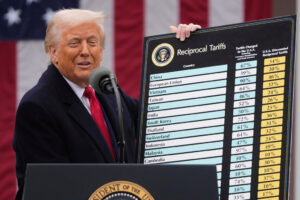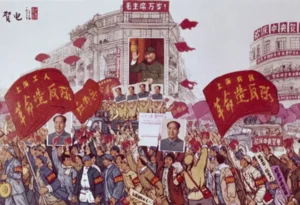“Title 8 Aliens and Nationality” Immigration Law: Chinese Asylum from Chasing after American Dream to Struggling in Structural Violence
The shift from Title 42 to Title 8 immigration law has profoundly impacted Chinese asylum seekers crossing the U.S.-Mexico border. Many migrants, fleeing political persecution and economic instability in China, find themselves trapped in a system that exacerbates their vulnerabilities rather than offering protection. Under Title 8, stricter asylum conditions and the introduction of “credible fear screenings” have intensified psychological burdens, while harsher penalties for re-entry have made migration riskier than ever. This article explores how structural violence within the U.S. Immigration policy continues to shape the fate of Chinese migrants seeking refuge in America.

Migrants crossing the Darién Gap, the only land-based route from South America to the U.S. (Fernando Vergara/ via AP News).
From the mass migration of the 1850s Gold Rush to the present-day exodus from an increasingly restrictive China, Chinese migrants have long faced systemic obstacles and shifting policies that dictate their struggles in reaching the United States.1 Many migrants choose unconventional routes, crossing Panama’s dangerous rainforest and the Mexican border to seek asylum in the U.S. Such a route, taken by many people such as Chinese asylum seeker Mr. Long, who fought his way across the Mexican border post-pandemic, is described as “spinning in the air and suddenly landing,” an overwhelming feeling” affecting sense of security.2 Many, like Mr. Long, initially believed that the repeal of the Trump-era Title 42 Expulsion public health law could prevent them from suffering the effects of structural violence. However, even though the Biden-administration repealed the law, enforcing the Biden-era “Title 8 Aliens and Nationality” immigration law exposed them to even more structural violence under the U.S. government. The Title 8 Aliens and Nationality law, which structures how border authorities handle illegal border crossers, dictates that those who want to legally seek asylum in the US need to meet the requirements of “failing to be granted asylum in a third country” and passing a “credible fear screening”.3
Compared to the provisions outlined in Title 42, the Title 8 immigration law imposes stricter controls on those seeking asylum, including regulations on the conditions for applying for asylum and restricting re-entry to the United States after the first repatriation. These measures not only exacerbate immigrants’ vulnerability, but also undermine their fundamental rights. To be more specific, Title 42 states that “all immigrants from pandemic-affected countries who illegally cross the U.S.-Mexico border guards will be deported to Mexico or their home country.”4 In contrast, Title 8 allows individuals who enter the United States illegally to apply for asylum through immigration courts or services. While this newer law provides an opportunity for immigrants to seek asylum, it requires the condition that they must have first failed to obtain asylum in a third country – provision which is vaguely defined. Such vagueness creates more challenges, causing many Chinese migrants to fail to meet the criteria.5 Since most Chinese immigrants who cross the U.S.-Mexico borders aim to reach the United States without seeking asylum in the transit countries, they are particularly vulnerable to the U.S. policy of “failing to seek asylum in a third country.” As a result, they often face rapid expulsion by U.S. authorities. For example, Mr. Gao, born in an underdeveloped area in China, rented a piece of land in Beijing in 2007, built a house, and rented it to migrant workers. In 2018, when the Beijing government wanted to take back the land for development, Mr. Gao refused to vacate the property. In response, he endured violence from the Chinese authorities, including cutting off the water and electricity from the house and pumping the toilet sewage into the yard to force him to leave. Although he won the administrative lawsuit against the government, he did not receive any compensation. He and his family continued to face harassment threats and even mental abuse by the government. In May 2023, he made the difficult decision to cross the U.S.-Mexico border to seek political asylum.6 However, if his asylum claim is denied, returning to China would leave him even more vulnerable.
Under Title 8, an additional layer has been introduced for those eligible to submit asylum applications. The primary purpose of adding the “Credible Fear Screenings” requirement is to assess whether an applicant’s claims are both genuine and credible, questioning why asylum seekers cannot return to their home country. 7This screening process places considerable psychological pressure on Chinese refugees, especially those persecuted by their government. They are required to recount their traumatic experiences several times due to the nature of the interrogation process. While experiencing anxiety and fear, these people still have to provide evidence to substantiate their claims. Furthermore, specific groups, such as Uyghurs in China or Falun Gong practitioners, may face heightened skepticism due to the complexity of or unfamiliarity with their persecution narratives, which are not always easily understood by outsiders, in this case, specifically U.S. border officers.
Additionally, expulsions under Title 42 did not carry immigration or criminal penalties, meaning migrants expelled to Mexico could repeatedly attempt to cross the border.y Many asylum seekers were successful when they entered the second or the third time. However, border crossings have become more challenging. According to Voice of America, approximately 4,300 Chinese nationals attempted to re-enter the U.S. from May to June 2023, but were ultimately unsuccessful under a new regulation barring, deported migrants from re-entering the U.S. for at least five years.8 Should they re-enter unlawfully, they risk criminal charges and incarceration. This law might lead some people to immediately think about going to other countries after deportation, rather than risking entering the U.S. again, further aggravating the plight of those who do not meet the asylum criteria. These restrictions not only prolong the suffering of vulnerable individuals but also deter potential asylum seekers. The fear of being barred from re-entry for an extended period dissuades many from even applying, effectively undermining their fundamental rights and access to protection.
In conclusion, the evolving landscape of the U.S. Immigration law—particularly the shift from Title 42 to Title 8—illustrates the complex balance between humanitarian objectives and structural violence. While these laws were initially intended to provide a framework for managing asylum seekers, the rigorous conditions and heightened scrutiny have intensified the vulnerabilities of migrants, particularly those fleeing from China. The requirement of establishing credible fear adds psychological burdens, forcing asylum seekers to relive their trauma under intense scrutiny. Moreover, the punitive measures linked to “Title 8” create formidable barriers that discourage many from seeking asylum, trapping them in a cycle of fear and uncertainty. As immigration policy in the US becomes more politically polarized, meaningful reform remains elusive. The failure to achieve comprehensive solutions over the past two decades highlights the urgent need for a more humane approach that recognizes the complexity of migration and prioritizes the protection of fundamental human rights. Without such reforms, the plight of vulnerable populations, including Chinese migrants, will continue, caught between political maneuvering and systemic obstacles.
- Chinese immigrants played a significant role in the Gold Rush (PBS, 2019). ↩︎
- So, Alvin Y. 2019. “THE RISE OF AUTHORITARIANISM in CHINA in the EARLY 21ST CENTURY.” International Review of Modern Sociology 45 (1): 49–70. ↩︎
- U.S. Customs and Border Protection. n.d. “Nationwide Enforcement Encounters: Title 8 Enforcement Actions and Title 42 Expulsions | U.S. Customs and Border Protection.” ↩︎
- U.S. Code Title 42 (OLRC Home, n.d.). ↩︎
- Montoya-Galvez, Camilo. 2023. “What Is Title 8, and What Has Changed along the U.S.-Mexico Border after Title 42’S Expiration?” Www.cbsnews.com. May 15, 2023. ↩︎
- Li, Yuan. 2023. “Why Do These Chinese Take the Risk of ‘Taking the Long Route’ to the United States?” The New York Times Chinese Website. December 5, 2023. ↩︎
- Nationwide enforcement encounters: Title 8 enforcement actions and Title 42 expulsions (U.S. Customs and Border Protection, n.d.). ↩︎
- Liu, Tracy. 2024. “Regretting Coming to the US, Some Chinese Immigrants Return Home.” Voice of America. April 8, 2024. ↩︎
Editors
Julia White, Managing Editor
Jacqueline Tong, Copy Editor

Yichen Gao is a second-year graduate student in International Relations at New York University (NYU). Her work sits at the intersection of migration and gender studies and the long history of U.S.–China relations (1700–present), with a special focus on how racism shapes law, policy, and everyday life. Before moving to New York, she studied East Asian Studies at the Chinese University of Hong Kong (CUHK), where she built a strong foundation in regional politics, transnational migration, and social movements.




